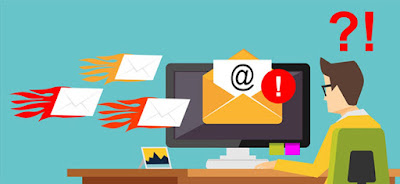WHAT IS EMAIL BOMBARDMENT?


TROJANS
Have you heard of Trojans? You will certainly know the
history of the Trojan horse. Like the mythical horse that the Greeks used to
enter Troy without anyone noticing, these programs try to enter your computer
without raising suspicions, opening a back door for a remote attacker to access
the computer.
What is unique about this malware is that it appears to
the user as an apparently legitimate and harmless program, but when it is run
it gives the attacker remote access to the infected computer.
What
is the mission of a Trojan?
The mission of a Trojan is to create a back door that
gives an unauthorized attacker access to your computer. And its objective is
not very different from other types of malware: stealing confidential and
personal information.
The most valuable information is undoubtedly financial
information and, for this reason, banks are especially concerned about Trojans
that reach computers through emails with attachments. If these files are
opened, the malicious code enters the computer and wanders around your house
like Pedro, until it manages to steal the online banking passwords stored on
that computer.
You may wonder how a Trojan could get the passwords for
your accounts. This occurs because Trojans are designed to allow an attacker to
access a system remotely and perform different actions without asking for
permission. Complicating the situation is the fact that a Trojan can be running
on a computer for months without the user noticing anything, but if you follow
our recommendations and pay attention to the behavior of your computer, you can
prevent the Trojan from taking your computer hostage.
How
a Trojan knocks on your door
A Trojan can knock on your door
Through an image or a link on an infected web page.
These Trojans enter our computer and wait in silence
until we connect to our online banking.
Other routes of entry are:
Infected devices (Mobile, USB, DVD)
Fraudulent websites (impersonating shops or banks) or
legitimate but infected websites.
File sharing programs (P2P)
How
do you know if a Trojan is camping on your computer?
Trojans, even if they try to go unnoticed, can leave
various signs of their stay on our computer.
If your computer shows any of these symptoms, you may be
in the presence of a Trojan:
Screen or pop-up windows with unusual messages. There is
no doubt: While there is software spyware installed on your PC, either has been
infected by a fake antivirus.
Suspicious behavior of the browser: the Internet browser
accesses by itself certain sites that we do not request, it opens and closes
windows by itself. It is an unequivocal sign of infection. Many threats drive
traffic to some unwanted sites.
Problems with connections. You cannot connect to the
internet or the connection is much slower than usual. The malware could be
establishing different connection sessions, which will undoubtedly steal our
bandwidth and make us browse very slowly or even become an almost impossible
task.
Slowness in the Operating System: continuous crashes or
the system restarts without the causes being known, programs that unexpectedly
begin or terminate their execution.
The antivirus disappears. Another feature of many
computer threats is the disabling of the security system you have installed.
How
to make life difficult for a Trojan?
To make things far more difficult for a Trojan, follow
these recommendations:
· Install
an original antivirus
and always keep it updated.
· Update
the applications and operating system.
· Always
be wary of emails from unknown senders.
· Do
not follow links or run attachments if you are not 100% sure of their origin.
An application that pretends to be from the bank, but in a software utility
generic, such as the one that allows watching videos in Flash format”.
How
to make your device protected from Trojan
To protect our device from Trojan viruses and to keep our
device healthy we should follow these 7 steps to stop Trojan enter your device.
7 steps to follow:
1.
Install a quality antivirus
Many people trust the antivirus that come with
Windows or Internet Explorer. However, these programs don't represent adequate
protection against the growing list of digital threats. It is said to have good
antivirus in your device.
2.
Install protection against real-time Trojans
Many users think that having an antivirus program that
includes protection against Trojans and spyware (spyware) is sufficient.
However, going without a full license program can be risky.
3.
Keep your antivirus programs updated
New threats to digital security arise every day, which is
why updating our protection programs is mandatory. Update them every 3-4 days
in a healthy manner
4.
Perform daily scans.
A virus sometimes escape and affects the device. Scheduling
daily scans of the entire hard drive can prove invaluable in detecting,
isolating, and removing harmful programs.
5.
Disable the “Autorun” or Auto-run
Some viruses operate by adding to external devices such
as USB / Flash drives, External Hard Drives or Network Drives. Windows users
can disable the auto-run function by following the instructions according to
their operating system version.
6.
Don't “click” on links in emails or attachments
Sometimes by distraction, users end up
"clicking" on attachments they receive by email, even knowing that it
is a risky action for their computers. Once this is done, the result may not be
seen at the moment, but a virus or Trojan may be acting on the computer's
memory, recording and stealing sensitive information.
7. Browse
smart
Major browsers have protection mechanisms that notify us
when we approach a potentially harmful website. Be careful while sharing your
information online. Always check if the page where it seems that we are is
indeed trustworthy. Check if the URL is for the organization or company. Some
hackers install web pages with an identical design to the original to confuse
us and appropriate our information.
Comments
Post a Comment